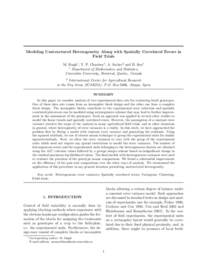Modeling unstructured heterogeneity along with spatially correlated errors in field trials

Authors:
In this paper we consider analysis of two experimental data sets for evaluating lentil genotypes. One of these data sets comes from an incomplete block design and the other one from a complete block design. The incomplete blocks contribute to the experimental error reduction and spatially correlated plot-errors can be modeled using autoregressive scheme that may lead to further improvement in the assessment of the genotypes. Such an approach was applied in several other studies to model the linear trends and spatially correlated errors. However, the assumption of a constant error variance restricts the scope of the analysis in many agricultural field trials, and in other situations in general, where heterogeneity of error variances is a reality. In this study, we have approached the problem first by fitting a model with constant error variance and generating the residuals. Using the squared residuals, we use K-cluster means technique to group the experimental units for similar squared-residuals. Next, we allow the error variances to vary with the group of the experimental units which need not require any spatial restrictions to model the error variances. The number of heterogeneous errors and the experimental units belonging to the heterogeneous clusters are obtained using the AIC criterion values followed by a groups merger scheme based on insignificant change in the residual maximum log likelihood values. The final models with heterogeneous variances were used to evaluate the precision of the genotype means comparisons. We found a substantial improvement on the effciency of the pair-wise comparisons over the other ways of analysis. We recommend the application of this procedure in any general situation permitting unstructured heterogeneity.
